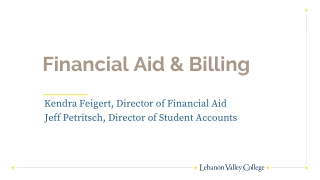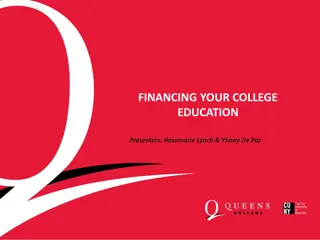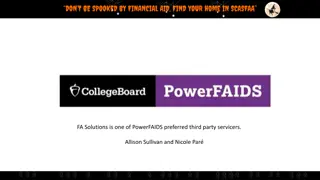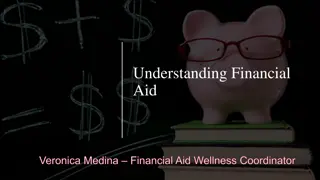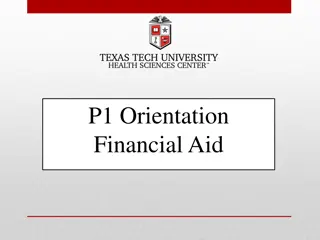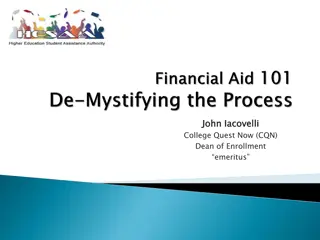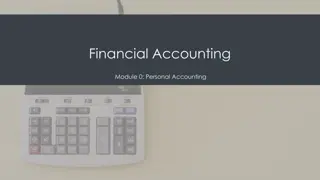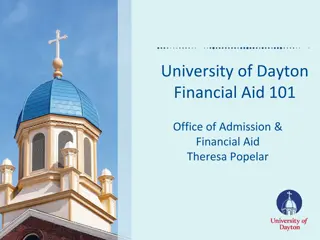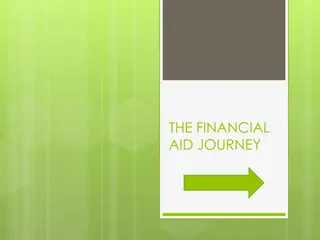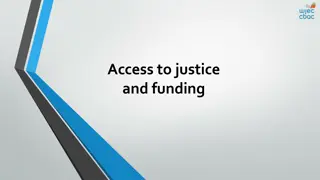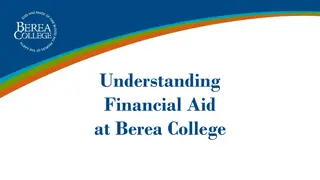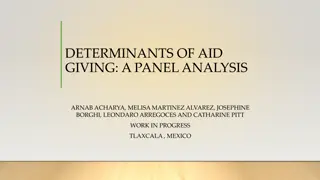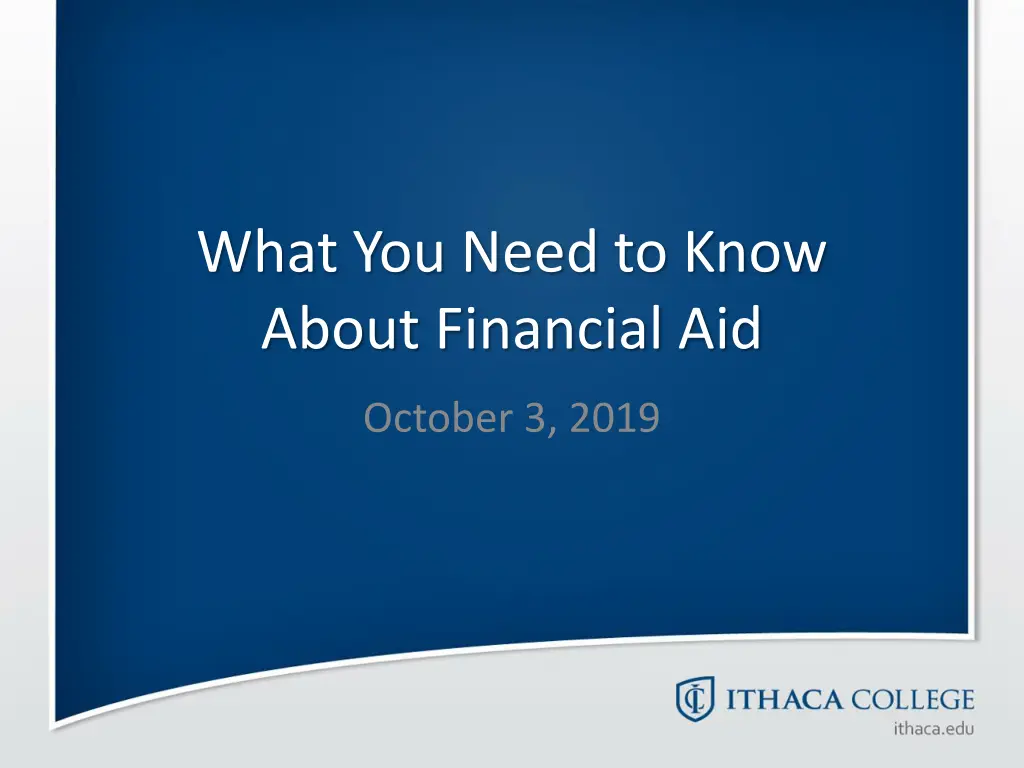
Understanding Financial Aid: Types, Components, and Application Process
Learn about financial aid, including what it entails, cost of attendance, expected family contribution, financial need calculation, types of aid available, and more. Discover how scholarships, grants, loans, and student employment options can help fund your education.
Download Presentation

Please find below an Image/Link to download the presentation.
The content on the website is provided AS IS for your information and personal use only. It may not be sold, licensed, or shared on other websites without obtaining consent from the author. If you encounter any issues during the download, it is possible that the publisher has removed the file from their server.
You are allowed to download the files provided on this website for personal or commercial use, subject to the condition that they are used lawfully. All files are the property of their respective owners.
The content on the website is provided AS IS for your information and personal use only. It may not be sold, licensed, or shared on other websites without obtaining consent from the author.
E N D
Presentation Transcript
What You Need to Know About Financial Aid October 3, 2019
Discussion Topics What is Financial Aid? Cost of Attendance (COA) Expected Family Contribution (EFC) Financial Need Categories, Types, and Sources of Financial Aid Forms to File Special Circumstances
What is Financial Aid? Financial aid is funding that helps students and families pay for educational expenses
What is Cost of Attendance (COA)? Direct costs tuition, room, board Indirect costs books, personal expenses, transportation Cost of Attendance is the combination of direct and indirect costs Varies widely from college to college
What is the Expected Family Contribution (EFC)? Amount family can reasonably be expected to contribute Includes discretionary income, borrowing ability, and assets Two components Parent contribution Student contribution Calculated using data from the FAFSA (and the CSS Profile for schools that require this form) Can vary from college to college depending upon required forms and institutional policies
What is the Financial Need? Cost of Attendance (COA) Expected Family Contribution (EFC) = Financial Need
Financial Need: An Example Tuition Room/Board Estimated Books Estimated Personal Expenses Direct Loan Fee 45,274 15,570 1,200 2,047 67 Cost of Attendance Expected Family Contribution 64,091 20,000 = Financial Need 44,091
Types of Financial Aid Scholarships Gift Aid Grants Loans Self-Help Aid Student Employment
Gift Aid: Scholarships Scholarships are typically not based on financial need Academic and/or Talent components Require full-time enrollment and cumulative grade point average (GPA) for renewal Do not need to be repaid
Gift Aid: Grants Grants federal, state, institutional aid based on financial need, typically do not have to be repaid Federal Pell Grants (EFC < $5,586), Federal SEOG, Teach Grants, Iraq and Afghanistan Service Grants NYS TAP Grants NYS TAP Grant awarded to dependent students whose families net NYS Taxable Income < $80,000. Awarded to independent students w/no tax dependents whose net NYS Taxable Income < $10,000.
Gift Aid: Grants Institutional Grants Usually limited at public institutions Private institutions will have more resources; remember that not all private colleges have the same funding levels to spend Ask each college what type of aid they offer and whether it is based on financial need? Check colleges financial aid websites and contact their financial aid offices Awards may change from year to year if financial need changes (based on annual FAFSA and CSS Profile, if required)
Self-Help Aid: Loans Money students and parents borrow to help pay college expenses Student Loans: repayment usually begins after education is finished Parent Loans: repayment begins after loan is fully disbursed, but can be placed in forbearance if needed. Only borrow what is really needed Look at loans as an investment in the student s future
Loan Types Federal Direct Subsidized and Unsubsidized Loans Subsidized is need-based and interest does not accrue while the student attends at least half time. Current interest rate is 4.53% Unsubsidized is not based on need and interest accrues from the time of disbursement. Current interest rate is 4.53% Federal Direct PLUS Loan (PLUS = Parent Loan for Undergraduate Students) Federal loan program available to parents to help meet their EFC. Current interest rate is fixed at 7.08%
Loan Types (continued) Private, Alternative Loans Loan programs that allow students/families to meet their educational costs Usually require a cosigner for student borrowers and the student must be 18 Interest rates can be variable or fixed Maximum eligibility is cost of attendance minus aid
Borrowing and Repayment General rule of responsible borrowing: Don t borrow more than expected first year salary in field of study. Monthly payment will typically be around 1% of total student loan debt. Example: $300 monthly payment on $30,000 debt
Self-Help Aid: Employment Student Employment Opportunities Federal Work Study based on financial need Students normally work 10-12 hours a week and are paid directly for any hours worked
Forms Multiple forms may be needed to apply for financial aid: FAFSA (Free Application for Federal Student Aid) Application from US Department of Education Determines eligibility for federal aid programs All schools require this form CSS PROFILE required by most private schools NYS TAP Application Required to apply for New York State grant assistance for New York State residents
FAFSA FAFSA is available October 1st for the 2020-2021 financial aid year https://fafsa.gov/FOTWWebApp/index.htm or https://studentaid.ed.gov/sa/fafsa No application fee Required by all institutions for federal aid eligibility Should file electronically Requires tax information from 2 years prior Required even if only applying for a Federal PLUS loan Filed annually for each year in school Most colleges set priority FAFSA filing deadlines Check with your college for FAFSA filing deadline
FAFSA Both parent and student will need an FSA ID to sign the application electronically Apply for the FSA ID prior to starting the application https://fsaid.ed.gov/npas/index.htm
Reasons to use FAFSA on the Web Built in edits to prevent costly errors Skip-logic allows student and/or parent to skip unnecessary questions Option to use IRS Data Retrieval Tool to import 2018 federal tax data More timely submission of original application and any necessary corrections More detailed instructions and help for common questions Ability to check application status online Simplified application process in the future
IRS Data Retrieval Tool While completing FOTW, applicant may submit real-time request to IRS for tax data IRS will authenticate taxpayer s identity If match found, IRS sends real-time results to applicant in new browser window Allows parents and students to access IRS tax return information and transfer data directly to FAFSA Applicant chooses whether or not to transfer data to FOTW This is the best way for colleges to verify income data on FAFSA
IRS Data Retrieval Tool Some will be unable to use the IRS DRT Examples include: You file with a tax status of married filing separately You indicate you will not file a tax return You file an amended tax return You file a foreign tax return Marital status has changed
Frequent FAFSA Errors Social Security Numbers Use exact spelling of name on social security card and correct social security number Divorced/widowed/remarried parental information Income earned by parents/stepparents Untaxed income U.S. income taxes paid Household size Number of household members in college Real estate and investment net worth
CSS PROFILE www.collegeboard.com $9 application fee and $16 charge for each school listed Used by most private colleges to award institutional funds Approximately 300 questions Must be filed electronically Corrections cannot be made online
NYS TAP NYS TAP Application (NYS residents only) Based on family s NYS taxable income Awards for 19-20 range from $500 - $5165 Must attend an eligible NYS institution Awards are for 8 semesters of full-time attendance Can link to application from the FAFSA submission confirmation page or go to https://www.tap.hesc.ny.gov/totw/
NYS Excelsior Scholarship Must be NYS resident at least 12 months prior to first day of enrollment Combined federal AGI cannot exceed $125,000 Must attend SUNY or CUNY Student must be enrolled in at least 12 credits each semester of award; must earn 30 credits per year Must agree to live and work in NYS after graduation for the same period of time as the award was received Maximum award is $5,500 -if eligible, recipient will receive a tuition credit from their school to cover remaining tuition charge
Net Price Calculator Mandated by the Department of Education All schools must have on their website as of October 29, 2011 Results are Estimated information only Does not guaranty admission
Award Notification Financial aid packages are released once all forms have been submitted and the student has been accepted for admission Single release date colleges may hold all packages and release on one set date Rolling release colleges release on a daily basis as packages are completed
Special Circumstances Circumstances that can be considered: Business Failure/Long term loss of employment Medical expenses not covered by insurance Loss of a spouse or parent whose income was used on FAFSA Parent divorce or separation after FAFSA has been filed
Special Circumstances Circumstances we are unable to consider: Consumer debt (mortgage, car, personal loans, credit cards, etc.) Inability to liquidate assets (such as rental properties) Cash flow problems Bankruptcy Adjustments to overtime pay
Outside Resources Explore outside agencies and local organization for awards Check with your employer Scholarship websites: www.fastweb.com www.finaid.org www.bigfuture.collegeboard.org Never pay to apply for scholarships
Helpful Websites www.studentaid.ed.gov www.collegescorecard.ed.gov www.mappingyourfuture.org www.collegecost.ed.gov www.fafsa4caster.ed.gov www.studentlendinganalytics.com www.collegeboard.org www.projectonstudentdebt.org www.studentloanborrowerassistance.org
Contact Information Sarah O Neil Assistant Director Student Financial Services Ithaca College soneil@ithaca.edu 800.429.4275 (phone) 607.274.1895 (fax) www.ithaca.edu/finaid sfs@ithaca.edu

